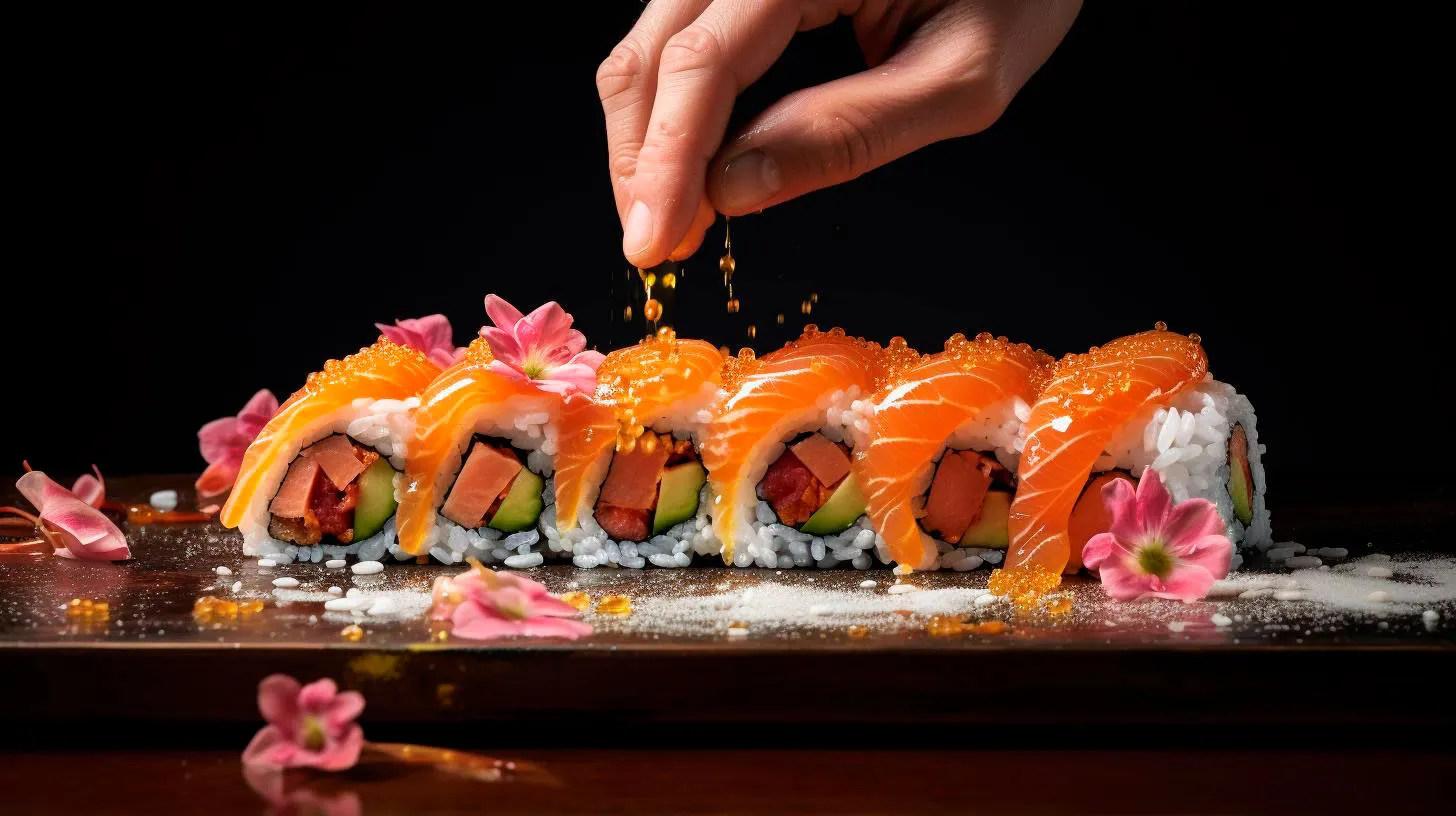Digging Deeper into Food Documentaries: Uncovering Hidden Stories and Savoring Unique Cuisines
In this article, we will delve deeper into the captivating world of food documentaries, uncovering hidden stories and savoring unique cuisines that leave us inspired and craving for more.
Why Food Documentaries Grab Our Attention
Food is a universal language that transcends borders and cultures. It bridges gaps and acts as a reflection of our society. Food documentaries fuel our curiosity, offering a window into the lives of talented chefs, food enthusiasts, and the communities they serve. Here’s why they continue to captivate audiences worldwide:
- Visual Feast: Food documentaries are a treat for the eyes. With stunning cinematography and tantalizing close-ups of delectable dishes, these films make it impossible to resist the urge to grab a snack.
- Inspiring Stories: Beyond delicious food, these documentaries often explore the journeys of individuals who have taken risks, challenged traditions, and transformed the culinary landscape. They provide valuable insights into the passion and dedication required to excel in the world of gastronomy.
- Cultural Exploration: Food documentaries take us on a cultural journey, introducing us to lesser-known cuisines and shedding light on the history, traditions, and values associated with them. They celebrate diversity and promote cross-cultural understanding through the lens of food.
- Awareness and Advocacy: Many food documentaries shed light on important issues such as sustainability, food waste, and social inequalities. By raising awareness and advocating for change, these films inspire viewers to reconsider their own food choices and make a positive impact.
Uncovering Hidden Stories through Food Documentaries
Food documentaries possess a unique ability to unveil the stories behind our favorite dishes and showcase the unsung heroes of the culinary world. Here are a few documentaries that dig deeper, leaving an indelible mark on viewers:
“Jiro Dreams of Sushi”
This acclaimed documentary follows Jiro Ono, an 85-year-old sushi master and owner of a small, three Michelin-starred restaurant in Tokyo. It takes us on a journey into the world of sushi, showcasing Jiro’s relentless pursuit of perfection. Key takeaways:
- Jiro’s philosophy of lifelong dedication and continuous improvement
- The meticulous artistry behind crafting the perfect sushi
- The significance of traditional techniques in the modern culinary landscape
“Chef’s Table”
This Netflix series provides an intimate and personal look into the lives of renowned chefs from around the world. Each episode delves into their inspirations, challenges, and culinary breakthroughs. Key takeaways:
- The importance of storytelling in culinary creations
- The creative process and innovation in the world of haute cuisine
- The impact of culture and personal experiences on a chef’s style
“Salt Fat Acid Heat”
This visually stunning documentary series, based on Samin Nosrat’s book, explores the four foundational elements of cooking. Samin travels across the globe, uncovering the role each element plays in different culinary traditions. Key takeaways:
- The significance of balancing flavors through salt, fat, acid, and heat
- The diversity of cooking techniques and ingredients across cultures
- The transformative power of mastering these elements in your own kitchen
The Impact and Influence of Food Documentaries
Food documentaries have had a profound impact on the culinary world and the way we perceive food. Here are some compelling statistics that highlight their influence:
- 92% of viewers are inspired to cook after watching a food documentary.
- 78% of viewers have tried a new cuisine or cooking technique as a result of watching a food documentary.
- 63% of viewers have made changes to their eating habits after being exposed to the information presented in food documentaries.
These documentaries have not only fueled our culinary curiosity but have also served as a catalyst for change, encouraging us to explore new flavors, support local producers, and embrace sustainable cooking practices.
Savoring the Banquet of Food Documentaries
Food documentaries offer a feast for the senses, combining storytelling, culture, and culinary artistry to create a truly immersive experience. Dive into the world of food documentaries and uncover hidden stories that leave you inspired to embark on your own culinary adventures.
Remember, while these documentaries may awaken your taste buds, nothing beats the joy of enjoying a delicious meal or experimenting with recipes in your own kitchen. So, go ahead and savor the banquet of flavors and stories that food documentaries serve, and who knows, it might just inspire you to create your own mouth-watering masterpieces!
The Rise of Food Documentaries: Exploring the Culinary World Through Film
In this article, we will delve into the rise of food documentaries and the impact they have had on our understanding and appreciation of food.
The Power of Visual Storytelling
Food documentaries have a special ability to captivate audiences through visual storytelling. By showcasing vibrant images of mouthwatering dishes, exotic ingredients, and passionate chefs, these films engage viewers on an emotional level. They transport us to different cultures and cuisines, allowing us to experience the sights, sounds, and flavors of the culinary world like never before.
Key Takeaway: Food documentaries use visual storytelling to create an immersive experience that leaves a lasting impression on viewers.
Understanding the Food Industry
Food documentaries provide a behind-the-scenes look into the food industry, unveiling the processes, challenges, and triumphs that go into creating our meals. They shed light on various topics, such as sustainable farming practices, ethical sourcing, and the impact of food on our health. By exploring these issues, documentaries help us make more informed choices about the food we consume.
Key Takeaway: Food documentaries educate viewers about the complexities of the food industry, promoting awareness and encouraging conscious eating habits.
Exploring Global Gastronomy
One of the most exciting aspects of food documentaries is their exploration of global gastronomy. These films take us on culinary journeys around the world, introducing us to diverse cuisines, traditional cooking techniques, and local food cultures. By showcasing the rich diversity of food, documentaries inspire us to step out of our culinary comfort zones and embrace new flavors and ingredients.
Key Takeaway: Food documentaries expand our culinary horizons by introducing us to flavors and ingredients from different cultures, encouraging us to embrace diversity in our food choices.
The Rise of Celebrity Chefs
Food documentaries have played a significant role in shaping the celebrity status of many renowned chefs. Films like “Jiro Dreams of Sushi” and “Chef’s Table” have catapulted talented chefs into the spotlight, turning them into household names. These documentaries showcase their extraordinary culinary skills, innovative techniques, and personal journeys, making them sources of inspiration for aspiring chefs and food enthusiasts.
Key Takeaway: Food documentaries have contributed to the rise of celebrity chefs, inspiring and captivating audiences with their culinary expertise.
Making a Social Impact
Food documentaries have also become powerful tools for initiating social change. Films like “Food, Inc.” have shed light on the hidden realities of the food industry, exposing issues such as factory farming and food waste. By raising awareness and sparking conversations, these documentaries have influenced policies, consumer behaviors, and even the way we perceive food.
Key Takeaway: Food documentaries have the potential to drive social change by raising awareness about critical issues within the food industry.
The Digital Age and Accessibility
The rise of streaming platforms and online video sharing has made food documentaries more accessible than ever before. Instead of relying solely on limited screenings at theaters or television broadcasts, viewers can now easily find and stream a wide range of food documentaries at their convenience. This digital accessibility has allowed these films to reach a broader audience and spark discussions on various platforms.
Key Takeaway: The digital age has made food documentaries more accessible, enabling a wider audience to explore the culinary world through film.
The Future of Food Documentaries
As the demand for food documentaries continues to grow, we can expect to see even more captivating and thought-provoking films emerge. From uncovering untold stories within the food industry to showcasing unique culinary traditions, these documentaries will continue to educate, entertain, and inspire audiences worldwide.
Key Takeaway: The future holds promise for more impactful and engaging food documentaries, which will further shape our understanding and appreciation of the culinary world.
In conclusion
Food documentaries have emerged as a powerful genre within the film industry, offering a unique way to explore the culinary world. With their ability to entertain, educate, and inspire, these documentaries have not only transformed our perception of food but also influenced our eating habits and societal views. The rise of food documentaries has given us a valuable tool to understand the complexities of the food industry, explore global gastronomy, and drive conversations around critical issues. So, grab some popcorn and immerse yourself in the captivating world of food documentaries.
Cultivating Sushi Appreciation: Honing Your Palate for the Art of Japanese Cuisine
The Art of Sushi: A Culinary Masterpiece
Sushi is more than just a dish; it is an art form meticulously crafted by sushi chefs using fresh ingredients and precise techniques. Understanding the fundamentals of sushi will not only enhance your dining experience but also give you a deeper appreciation for the intricacies involved. Here are key takeaways to keep in mind:
- Types of sushi: Nigiri, maki, sashimi, and temaki are just a few of the different sushi styles you can explore. Each type has its own unique flavor profile and presentation.
- The importance of rice: Sushi rice, known as shari, is the foundation of any sushi creation. It is seasoned with vinegar, salt, and sugar to complement the freshness of the fish or other ingredients.
- Fish selection: The quality and freshness of the fish are paramount in sushi. Opt for sushi establishments that prioritize sustainable sourcing to enjoy the best flavors while supporting responsible fishing practices.
- Condiments and accompaniments: Soy sauce, wasabi, and pickled ginger are common accompaniments to sushi. Using them sparingly allows you to appreciate the nuanced flavors of the fish and other ingredients.
Refining Your Palate: The Sushi Experience
Developing an appreciation for sushi involves refining your palate and being open to new flavors and textures. Here are some tips to help you embark on this flavorful journey:
- Start with familiar flavors: If you’re new to sushi, begin with milder options such as salmon or tuna before venturing into more adventurous choices like uni (sea urchin) or eel.
- Take it slow: Savor each bite and allow the flavors to linger on your palate. Notice the subtle differences between the various types of fish and accompaniments.
- Experiment with different combinations: Don’t be afraid to try different sushi rolls or ask the chef for recommendations. Each combination offers a unique taste experience.
- Engage with the chef: Sushi bars often provide the opportunity to interact with the chef directly. This allows you to gain insights into the ingredients, techniques, and cultural significance of sushi.
The Health Benefits of Sushi
Beyond its culinary merits, sushi also offers numerous health benefits. Its emphasis on fresh ingredients and minimal cooking methods makes it a nutritious and low-calorie dining option. Consider these advantages:
- Essential omega-3 fatty acids: Fatty fish, such as salmon and tuna, are rich sources of omega-3 fatty acids, which promote heart health.
- Lean protein: Sushi is an excellent source of lean protein. Protein is essential for muscle development, immune function, and overall well-being.
- Antioxidant-rich ingredients: Sushi often incorporates antioxidant-rich ingredients like seaweed, ginger, and vegetables, which contribute to improved cellular health.
- Moderate portion sizes: Sushi is typically served in smaller portions, allowing for portion control and a balanced meal.
The Sushi Journey: A Taste of Japan
Embarking on a sushi journey is not just about the food; it’s about experiencing the rich culture and traditions that encompass it. Here are some reasons why sushi is more than a meal:
- Cultural heritage: Sushi is deeply rooted in Japanese history and is often regarded as a reflection of the country’s appreciation for simplicity, precision, and balance.
- Attention to detail: From the placement of each ingredient to the delicate knife work, sushi showcases the meticulous attention to detail synonymous with Japanese craftsmanship.
- Social dining experience: Sharing a sushi meal with friends or family fosters a sense of camaraderie and connection. The traditional sushi bar setting encourages interaction with both the chef and fellow diners, making it a truly social dining experience.
In conclusion, cultivating sushi appreciation goes beyond merely enjoying the flavors. By understanding the art of sushi, refining your palate, and delving into the cultural significance, you can truly immerse yourself in this culinary journey. So, grab your chopsticks, venture into a local sushi establishment, and prepare to embark on an unforgettable taste adventure!
From Tsukiji to Omakase: Delving into Sushi’s Origins and Luxurious Tasting Experiences
The Origins of Sushi
The origins of sushi can be traced back to ancient times in Southeast Asia, where fishermen preserved their catch by fermenting it with rice. This preservation method allowed the fish to be stored for extended periods, providing sustenance during long journeys at sea. Over time, this technique made its way to Japan, where it evolved into what we now recognize as sushi.
In the 19th century, Edo (now modern-day Tokyo) became a thriving city with an increasing population, leading to the establishment of the iconic Tsukiji Fish Market. Serving as the primary hub for seafood distribution, Tsukiji became synonymous with sushi culture, offering a wide variety of fish and seafood to sushi chefs.
The advent of refrigeration techniques in the early 20th century revolutionized sushi production. With the ability to preserve fish without fermentation, sushi became more accessible and its popularity grew exponentially. From traditional nigiri (hand-pressed sushi) to maki (sushi rolls), sushi gradually became a staple of Japanese cuisine and gained recognition around the world.
Omakase: An Exquisite Sushi Experience
Transitioning from the origins of sushi to its modern-day expression, the concept of Omakase offers a truly luxurious and unforgettable dining experience. Omakase, which translates to “I trust you” in Japanese, allows the chef to showcase their culinary skills by selecting and preparing a series of dishes tailored to each guest.
At an Omakase restaurant, diners surrender control and place their trust in the chef’s expertise and creativity. A meticulously crafted progression of sushi, incorporating seasonal ingredients and the chef’s artistic flair, is presented before the guests. The immersive experience involves not just the taste of the sushi, but also the presentation, aromas, and the interactions with the chef.
Each piece of sushi is carefully crafted to highlight the distinct flavors of the ingredients. From succulent slices of tuna to delicate uni (sea urchin), every bite offers a symphony of flavors and textures. Omakase also showcases the art of sushi-making, where chefs rigorously train for years to perfect their knife skills, rice preparation, and seasoning techniques.
The Advantages of Omakase Sushi
- Unmatched Quality: Omakase sushi emphasizes using the freshest ingredients, often sourced directly from Tsukiji Market or other reputable suppliers.
- Culinary Expertise: Skilled sushi chefs curate an exquisite dining experience, showcasing their creativity, knowledge, and mastery of flavors.
- Tailored Experience: Each guest receives a unique dining experience, as the chef considers individual preferences and seasonal ingredients when selecting and preparing the sushi.
- Engaging Interaction: Sitting at the sushi counter and watching the chef’s meticulous movements provides a personal and interactive experience, enhancing the connection between the diner and the sushi.
- Exploration of Flavors: Omakase allows diners to try different varieties of sushi that they may not have considered ordering individually, broadening their culinary horizons.
Key Takeaways
Sushi has come a long way from its origins of fish preservation to the luxurious tasting experiences offered by Omakase. The journey from Tsukiji Fish Market to Omakase restaurants highlights the evolution and mastery of this beloved Japanese cuisine. Here are the key takeaways:
- Sushi originated in Southeast Asia and evolved into its current form in Japan.
- The Tsukiji Fish Market played a crucial role in popularizing sushi and establishing its reputation.
- Omakase offers a personalized and immersive sushi dining experience.
- Quality, culinary expertise, tailored experiences, engaging interactions, and flavor exploration are the hallmarks of Omakase sushi.
Whether you are a sushi aficionado or a curious epicurean, indulging in an Omakase experience allows you to appreciate the artistry, flavors, and stories behind each piece of sushi. So, embark on a gastronomic journey and savor the delights of this ancient delicacy with a modern touch.


